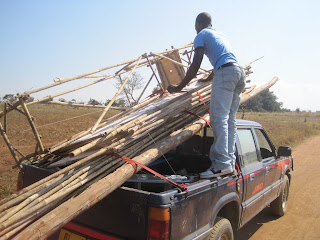A while back, I
posted about our seed trial using seeds from ECHO (www.echonet.org). With the end of the rains, the trial is (almost) complete. Here are some results, conclusions and future plans for some of the crop varieties we grew:
1. Winged Bean: low production. Given that this is the second time we have tried growing this crop in Malawi, and that both attempts resulted in low yields, I have only to conclude that it is not well suited to our environment or method or both. Germination rate was good. All plants produced many flowers, but most plants did not produce seed pods. This would seem to be a pollination issue, though it may have been due to drought. I would not discourage others from trying this climbing vine. The leaves are delicious all the same. This crop is not known by the farmers we work with.

2. Millet: good production. Extremely easy to manage. We will cultivate this one again, and promote it if we can come up with any recipes that don't involved fermentation. Might be good toasted in porridge or breakfast cereals (granola, etc.). The yield was not high, but the crop is so easy to manage it's worth putting a few rows in a larger garden. Millets are grown in Malawi, but this variety seemed to be a bit different. Local varieties are tall with one large seed-head at the top. This variety was short, grass-like, and produced many seed-heads from each tuft.
3. Grain Amaranth: very good production. Amaranth is known as
bonongwe in Chichewa. It grows wild and the leaves are eaten like spinach. Some varieties are not eaten. The Grain Amaranth we grew in the trial produced a much larger seed head than most local varieties. We will promote this crop and/or the harvesting of wild seeds, which can as well be pounded into flour. The flour or toasted seeds adds well to porridge and soups.
4. Pigeon Pea: Our stand of Pigeon Pea is just producing seeds now. I was experimenting with a much closer planting than recommended given the small size of the garden. Such close spacing would work well as a hedge or boundary. The leaves are well liked by rabbits. This crop is grown in Malawi, but rarely on a large scale. It is called
nandolo. We may promote this crop within the wetlands to demarcate paths and gardens.

5. Tomato: The tomato plants have produced well, though not as well as store bought varieties. The real test will be whether the second generation and onward maintain the level of production. I will continue to grow this variety, and I may share some seeds around in the future.

6. Cowpea: A great success. I had high hopes for this crop after what I saw at the ECHO Agriculture Conference in December 2010. I was not disappointed. I planted this climbing bean stalk at a slightly closer distance than recommended with the expectation that seed production may be reduced. The experiment was to verify the effectiveness of cowpea as a cover crop that could be planted later but still grow to the point that it covers the entire garden floor. The trial was successful. With a planting date in the first week of January, the cowpea would be able to grow up behind knee-high maize without overwhelming the primary crop. We will try this green manure with farmers. Cowpea is grown locally; it is called
khobwe.

7. Italian Edible Gourd: failure. Perhaps we did something wrong (late planting may have brought on disease), but this crop did not fair well. Typically, gourds, pumpkins, squashes, etc, do well either planted with the first rains or under irrigation. It sounds like a delicious vegetable, but we'll stick with local pumpkins for now.
8. Carrot: the carrots have done well. My understanding is that carrots produce seeds in their second year, but this was not indicated on the ECHO Plant Information Sheet. Would have been nice to know before hand so that I could have planted them in a corner of the garden, instead of the dead center.
9. Sunflower: decent yield, poor germination. We experienced a low germination rate for sunflower, perhaps due to flooding a few days after planting. The plants that survived yielded about a pound of seeds, which will give us a decent start next year. Unfortunately, diversity was lost but we will see how the seeds do in future generations. In Chichewa, Sunflower is known as
mpendadzuwa, or "follows the sun".

10. Moringa (from 2010): there are now moringa trees scattered around my house. The trees grow well but need plenty of water during the dry season, especially during their first year. Farmers know about this tree and its uses, but tree planting is not a common practice among Malawians. We will try to promote this tree with farmers. In Chichewa it is commonly call
chamwamba, because it produces food overhead.
11. Vegetable Amaranth (from 2010): these seeds are still producing, 2 generations on. Malawians like the taste of the leaves, but the red colour is not appetizing. If mixed with other
bonongwe leaves, it is more appealing.








